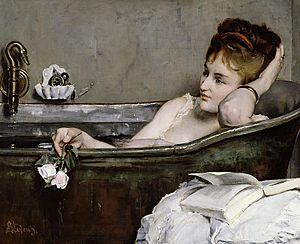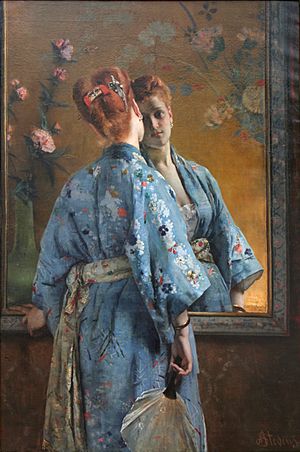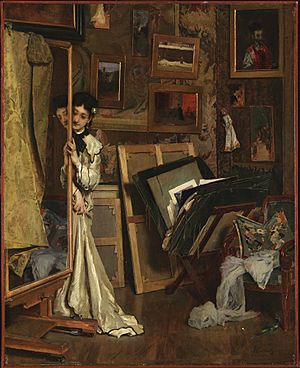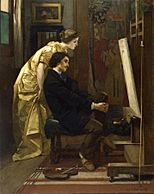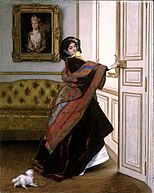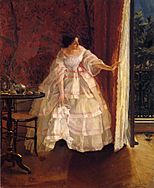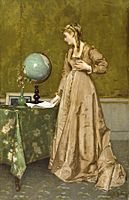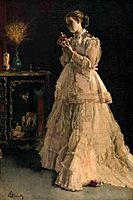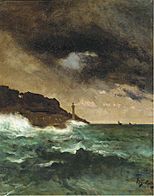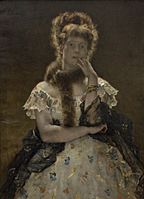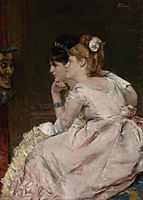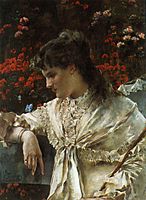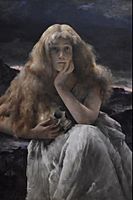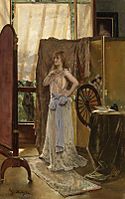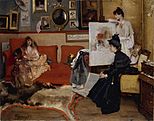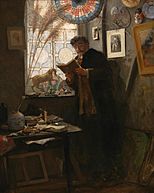Alfred Stevens (painter) facts for kids
Quick facts for kids
Alfred Stevens
|
|
|---|---|
 |
|
| Born |
Alfred Émile Léopold Stevens
11 May 1823 |
| Died | 24 August 1906 (aged 83) |
| Nationality | Belgian |
| Known for | Painting |
|
Notable work
|
What is Called Vagrancy, The Psyché, The Parisian Sphinx |
| Movement | Social realism, Realism, Orientalism, Dutch realism style |
Alfred Émile Léopold Stevens (born May 11, 1823 – died August 24, 1906) was a famous Belgian painter. He was best known for his beautiful paintings of stylish women from his time. His art looked very real and was carefully finished. This showed how much he was influenced by 17th-century Dutch paintings that showed everyday life.
Early in his career, he became known for a painting about poor people. Later, he became very successful by painting scenes of rich Parisian life. He often used the same people as models in his paintings.
Contents
Alfred Stevens: His Family and Early Life
Alfred Stevens was born in Brussels, the capital of Belgium. He came from a family deeply involved in art. His older brother, Joseph, was also a painter. Another brother, Arthur, was an art dealer and critic. Alfred's father was an art collector who owned paintings by famous artists like Eugène Delacroix.
His mother's parents ran a popular cafe in Brussels. This cafe was a meeting place for important politicians, writers, and artists. Growing up around such interesting people helped all the Stevens children learn important social skills.
Becoming a Painter: Alfred's Education
After his father passed away in 1837, Alfred left school. He began studying art at the Académie Royale des Beaux-Arts in Brussels. There, he learned from François Navez, a well-known painter. For his first two years, Alfred drew from copies of old sculptures. Then, he moved on to drawing from live models.
In 1843, Stevens moved to Paris, France, to join his brother Joseph. He got into the École des Beaux-Arts, which was the most important art school in Paris. By 1849, Alfred had already mastered a realistic painting style. He carefully studied the works of Dutch painters like Gerard ter Borch and Gabriel Metsu.
Starting His Career: Early Successes
Alfred Stevens first showed his art to the public in 1851. Three of his paintings were displayed at the Brussels Salon. He won medals at the Paris Salon in 1853 and the Universal Exposition in Paris in 1855.
One of his most famous early works was Ce qu'on appelle le vagabondage (What is Called Vagrancy), painted in 1854. This painting showed poor people being picked up from the streets. It even caught the attention of Napoleon III, who was the Emperor of France. Because of this painting, Napoleon III ordered that soldiers should no longer be used to arrest poor people.
In 1857, Stevens made his first big sale to a private collector. He also started to become part of the lively art scene in Paris. He met famous writers and artists like the Goncourt brothers and Alexandre Dumas.
In 1858, Stevens married Fanny Juliette Albertine Marie Hortense Blanc. She came from a wealthy Belgian family. The famous painter Eugène Delacroix was even a witness at their wedding! Alfred and Fanny had four children together.
A Famous Artist: His Mature Career
During the 1860s, Stevens became a very successful painter. He was known for his paintings of elegant, modern women. His art shows at the Salons in Paris and Brussels received great reviews and attracted many buyers.
A great example of his work from this time is La Dame en Rose (Woman in Pink), painted in 1866. This painting shows a stylish woman in a room filled with Japanese objects. Stevens was one of the first artists to be interested in Japonisme, which was a popular trend for Japanese art and style.
In 1863, the French government gave him the Legion of Honor, a very important award. By 1867, he was promoted to Officer of the Legion of Honor. He was considered one of the stars of the Belgian art section at the Universal Exposition in Paris.
Stevens was friends with many famous artists and writers of his time. These included Édouard Manet, Edgar Degas, and James Abbott McNeill Whistler. He often met with them at the Café Guerbois in Paris.
Stevens fought for France during the Franco-Prussian War. After the war, he continued to be praised by critics and collectors. In 1875, he bought a grand house and garden in Paris. This house even appeared in some of his own paintings and those of other artists, like Édouard Manet.
Even though he earned a lot of money, Stevens faced financial problems in the 1880s. This was due to some bad investments and spending too much. Doctors also told him that spending summers by the sea was important for his health. Because of this, he made a deal with an art dealer named Georges Petit. Petit would pay for his vacations, and Stevens would paint pictures of the sea.
This deal lasted for three years. It led to the sea becoming a very important subject in his art. For the rest of his career, he painted hundreds of scenes of popular resorts along the coast of France. Many of these paintings had a quick, sketchy style, showing the influence of the Impressionist painters.
Stevens also began teaching art to private students. Some of his famous students included the actress Sarah Bernhardt and the American painter William Merritt Chase.
Later Years and Legacy
One of the most important works from the later part of Stevens's career was a huge painting called Panorama du Siècle, 1789–1889. He painted this with another artist, Henri Gervex, and many assistants. It was shown to great praise at an exhibition in Paris in 1889.
Stevens received several other important honors. In 1895, a large exhibition of his work was held in Brussels. In 1900, he was the first living artist to have a special exhibition of his work at the Ecole des Beaux-Arts in Paris. In 1905, he was the only living artist allowed to show his work in a special exhibition of Belgian art in Brussels.
Despite these honors, he struggled to sell enough paintings to be financially comfortable. He passed away in Paris in 1906, living alone in modest rooms, but still in touch with his four children.
Honours
- 1881: He was made a Grand Officer in the Order of Leopold. This is a very high honor in Belgium.
Selected works
See also
 In Spanish: Alfred Stevens para niños
In Spanish: Alfred Stevens para niños
- 13058 Alfredstevens


